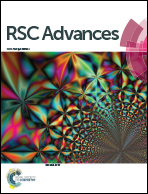One-pot hydrothermal synthesis of CuO with tunable morphologies on Ni foam as a hybrid electrode for sensing glucose†
Abstract
CuO microstructures with urchin-like, flower-like and sheet-like morphologies were directly grown on a Ni foam via a simple and low-cost hydrothermal method. The aim was to construct a three-dimensional porous hybrid electrode for an amperometric non-enzymatic glucose sensor. As a result, the as-prepared hybrid electrode with a flower-like morphology exhibited a higher electrocatalytic activity towards the oxidation of glucose compared to electrodes with other morphologies and a pristine Ni foam electrode. The flower-like CuO/Ni foam electrode displayed a high sensitivity of 1084 μA mM−1 cm−2 to glucose ranging from 0.5 μM to 3.5 mM, which is higher than most of the reported CuO based electrodes, and also a low detection limit of 0.16 μM (signal/noise = 3). Notably, poisoning by chloride ions and interference from ascorbic acid, uric acid, dopamine, and sucrose were negligible. These results indicate that the flower-like CuO/Ni foam hybrid electrode is a promising candidate for amperometric non-enzymatic glucose detection.


 Please wait while we load your content...
Please wait while we load your content...